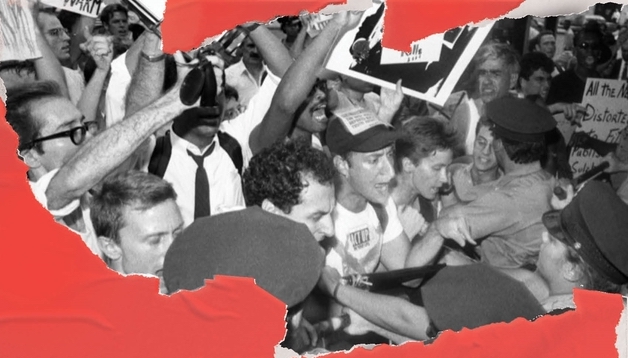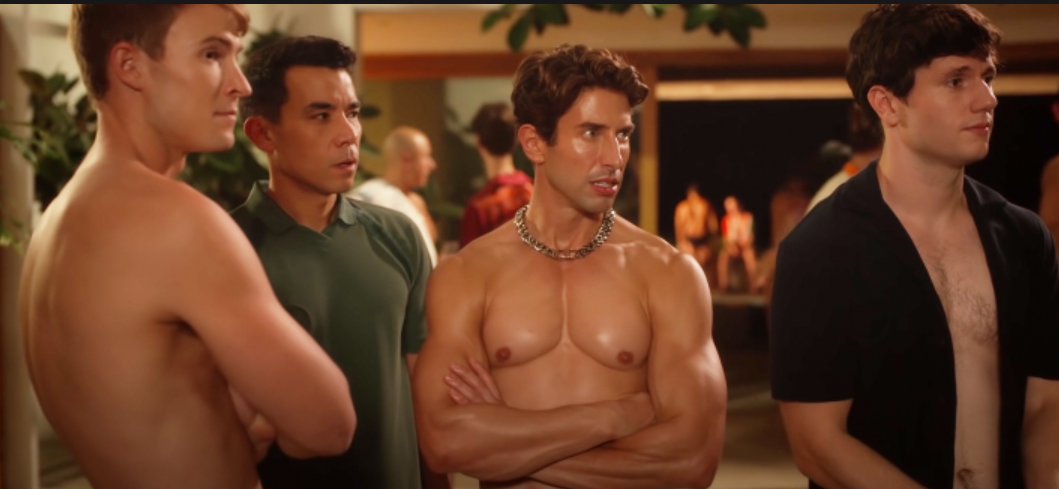interviews
The Unvarnished Story Behind the Most Controversial Group in AIDS Activism
Sarah Schulman, author of "Let the Record Show," on the history of ACT UP New York

When was the last time you cried?
That question appeared on a poster in 1993 by Gran Fury, a collective of 11 artists and AIDS activists. The poster is strikingly simple, nothing but a blank, crinkled sheet with small text centered vertically in the frame: Do you resent people with AIDS? Do you trust HIV-negatives? Have you given up hope for a cure? When was the last time you cried? The piece—titled plainly, deliberately, “The Four Questions“—confronts the trauma of the AIDS crisis through alternating perspectives of positive and negative people, as though the artists are inviting us into their ruminating thoughts. All questions, no answers.
I learned about Gran Fury from Sarah Schulman’s latest book Let the Record Show: A Political History of ACT UP New York, 1987-1993. This tour de force narrates the early years of the New York chapter of ACT UP (AIDS Coalition to Unleash Power) as told to Schulman and documentary filmmaker, Jim Hubbard, through 188 recorded interviews with surviving members. (Full interview transcripts are archived and available for free at the ACT UP Oral History Project.)
The book is full of fascinating people and events whose history would be common knowledge if our public schools were less homophobic and better funded. I never knew, for example, that until ACT UP pressured the CDC, women were categorically excluded from the definition of AIDS; or that they staged demonstrations at the New York Stock Exchange, St. Patrick’s Cathedral, Guantánamo Bay, and the NIH headquarters. Like most people, the bulk of my AIDS education comes from movies and television—Philadelphia, Angels in America, Dallas Buyers Club, and more recently, Pose. Schulman dispels myths about AIDS history found in these pop culture representations. She tells the truth.
The last time I cried was during the conclusion to Let the Record Show, when I encountered an unexpected moment of intimacy in the cancer unit of a hospital between an ailing writer and her nurse. Upon learning the writer is an AIDS historian, the nurse begins sharing memories of treating AIDS patients in the 1980s and then suddenly chokes up. The writer and nurse sit for a moment in quiet remembrance. “This, I know, is the enduring relationship of AIDS,” Schulman writes.
I spoke with Sarah Schulman over Zoom about AIDS narratives, grassroots organizing, the political use of anger, and more.
Zach Shultz: I sort of read your title as having a double meaning. On the one hand, you’re referencing the art installation by Gran Fury at the New Museum in 1987, where they took the names of certain politicians and put them on tombstones with the photographic stills of the Nuremberg trials in the background. And that was an ironic way of trying to call for this justice that never actually happened, to hold these people in power to account. But also, this book is seeking to correct certain narratives out there. What is it that you want the record to show about ACT UP and about AIDS history more generally?
Sarah Schulman: Well, most importantly, that in America, change is not made by heroic individuals. It’s made by groups and coalitions of very diverse kinds of people, usually working in some kind of silo with like-minded people but standing together in a way that their work resonates with each other.
The second thing is that this movement was really the last social movement in America that was to some degree successful. And it’s very important to look at why and also to see what its limitations were. I think the biggest takeaway is that it was not a movement that worked on consensus. It was a big tent movement that had a lot of flexibility. There was a statement of unity, which was: “Direct action to end the AIDS crisis.” That meant direct action, not service provision. And if that’s what you were doing, you could do whatever you wanted. There was a kind of radical democracy that we’re very far from now, and that is really important to remember.
ZS: It seems like another thing you’re doing with this work is counteracting an image of ACT UP as only gay, white, middle-class men. You’re showing all these other different types of affinity groups and other actors that were important within the movement. Can you talk about why that image is out there and how much more diverse the movement actually was?
SS: One thing that’s very hard to remember now is that in the 1980s, the media, the government, and the corporate sector were almost all white males. And gay men who were in those sectors were closeted, for the most part. So, when the media looked at ACT UP, they saw other white males, and that’s who they interviewed and that’s what they represented.
But you know, it turns out there’s a very big difference between an exclusively white male movement and a predominantly white male movement. Because when women and people of color participate, they have enormous influence. And I really am very specific about that—about which ideas, which individuals brought from previous movements and which previous experiences, so that you can see ACT UP would not have succeeded without the influence of women and people of color.
ZS: Right. This reads almost like a handbook for people who want to do grassroots organizing. You mentioned that it wasn’t based on consensus. That there was a very radical democracy model in the Monday night meetings. So, can you talk about ways that [model] worked and ways it created some challenges for accomplishing your goals?
SS: Well first, the Monday night meetings were like a nexus. People who work in ACT UP were also involved in lots of other communities… working with homeless people, with Haitians, with prisoners, with mothers, with drug users. Then the Monday night meeting was a predominantly white gay male, but also female, gathering. If you only look at the Monday night meeting, you don’t see where ACT UP actually was.
In America, change is not made by heroic individuals. It’s made by groups and coalitions of very diverse kinds of people.
A really great example would be, there was no legal needle exchange in New York City. Mayor [David] Dinkins opposed it, even though he was African American and more progressive. So, people in ACT UP decided to do the civil disobedience of breaking that law, getting arrested, and having a trial. They won and made needle exchange legal in New York. But if you thought that that was a terrible thing, and you didn’t want to be part of it, you wouldn’t try to stop them from doing it. You just wouldn’t do it.
If you wanted to go interrupt mass at St. Patrick’s Cathedral and somebody else didn’t want to, they just wouldn’t go. And I quote people in the book saying, “Well, I didn’t go to that,” or “That wasn’t where I put my energies.” But this idea of stopping other people from doing what they needed to do, that just was not operative.
ZS: And did this just come about organically? Or was it a conscious, strategic decision?
SS: It was not conscious. In fact, it was never overtly stated. It’s something that I cohered by listening to everybody and sort of setting the period. Because ACT UP never theorized itself. A lot of things that it did, it just did. And it never decided to do them, never commented on them, because people were dying, and there was really no time for any of that.
Let me give an example: Somebody from the front of the room would say, “We need someone to write a letter to this person.” And someone else would say, “I’ll do it!” And no one would ever check on them. No one would re-read the letter or try to control it. You just let people do what they said they were going to do. They wanted to live. They were going to do it. And it just went on like that.
The biggest example I give is at the St. Patrick’s demonstration, December 1989, when the organization decided to do a silent die-in inside the church. So, we all went in there with 7,000 people screaming outside, but Michael Petrelis jumped on the pew, blew a whistle, and screamed at [Cardinal] O’Connor, “You’re killing us! Stop killing us!” And you know, chaos ensued. But it turned out to be for the best.
But at the meeting, nobody said to him, “You went against us, so we’re throwing you out!” Never. No one was ever thrown out. Because in order to do that to somebody, you had to have a sense of supremacy or elite-ness or superiority. These were people who didn’t have basic legal rights. Gay sex was not legal nationally until 2003. It just wasn’t like that.
When I interviewed him years later, I was like, “So Michael, why did you do that?” And he said, “Well, I was really angry because no one would let me be in their affinity group.” It’s a very human, messy thing. And a lot of things in ACT UP were like that. I mean, people OD’d and died, people stole money, people pretended they had HIV. I mean, it was messy and very difficult. But these are real people. They’re not clean, and they’re not pure.
ZS: One thing I find so fascinating about this is the idea of anger itself. We often associate that with something negative… or destructive. Especially in the Trump era, we’ve seen how anger can be wielded by the Far Right and manifested violently, like in the attack on the Capitol on January 6th. But your work is shot through—not only in Let the Record Show, but also in other books I’ve read of yours—with a sense of anger and rage and indignation. So, I’m wondering: How can anger animate politics and art in ways that affect positive social change? And how might we distinguish between rage that is generative or destructive?
Anger, when it comes from a place of being oppressed, is different than anger that comes from wanting to protect a place of supremacy. They use the same word, but it’s not the same experience.
SS: One thing is that ACT UP never committed an act of violence, which is very interesting considering that people knew they were going to die… ACT UP had violence done against them. People were beaten. There’s a guy, Chris Hennelly, who’s had permanent brain damage from police violence. But ACT UP never committed an act of violence. And interestingly, they never voted to be nonviolent. They always kept the option open, but they never exercised it.
Because anger, when it comes from a place of being oppressed, is quite different than anger that comes from wanting to protect a place of supremacy. They use the same word, but it’s not the same experience.
ZS: So, going back to St. Patrick’s Cathedral, the Stop the Church demonstration on December 10, 1989. There was a part in the book where you talk about how this demonstration has been represented recently on the television series Pose. And when ACT UP members saw [the show], there was some anger about that portrayal being inaccurate. I don’t know if you’ve also watched another television show that recently came out called It’s a Sin?
SS: Yes, I saw that.
ZS: There’s one scene where they go to an ACT UP protest to lie down in the streets… But they never mentioned the name “ACT UP.” It’s all decontextualized and depoliticized. What do you think about these narratives being told about AIDS and about ACT UP from within certain dominant cultural institutions? Like, what’s missing from the stories that we’re telling? And what are people getting wrong?
SS: Well, they’re getting everything wrong, and it’s always been that way. Representations of AIDS have never accurately represented the mass political movements that forced change in this country… If you pretend that it’s individuals who cause social transformation, it’s much more acceptable for corporate film studios. Corporate culture likes that message, but it’s not true.
The issue with Pose was that there were, of course, people of color in ACT UP, but [the show] didn’t represent them. They ignored them and then created people who were not there, by creating Black trans women who did not get arrested at St. Patrick’s Cathedral. One trans woman did get arrested, but she was white. Kathy Otter, who was the elected facilitator of ACT UP, actually. So why not tell her story, too?
ZS: What did you think of It’s a Sin?
SS: Well, It’s a Sin is kind of at the end of the old way of telling [the story] … What I think they captured that was accurate was how young everyone was, how fun it was, how great it was to get away from homophobic families and have that freedom… But the fact that everyone who was positive died is absurd and not helpful to anybody. That the only woman they focused on was asexual, apparently, had no personal life, and her whole life was serving people. I mean, it was kind of crazy. It’s so far from reality that hopefully after my book comes out, that kind of thing won’t be possible again.
ZS: One thing you mentioned that [the show] got right, and I saw in your book as well, is this idea of activism as being fun, or being charged with erotic energy. Like people would go to ACT UP to meet partners or hook up, and they would go to a zap in the morning, and then a party at night, or go straight from the clubs to a shift at the hospital to watch somebody. And that piece gets lost in the ways we think about politics as something very serious.
Just because you’re alive doesn’t mean that you’re fine.
SS: Well, most political movements have to be things that make the lives of the people in them better. Otherwise, they don’t work. And this was a movement for people’s lives by very, very young people who had been really excluded and marginalized from their families, from the places they were born. They did not have loyalty to the system. They had much more loyalty to each other. And so, they had to live their whole lives by the time they were 25 or 26. They had to live everything because they were going to die.
So, it was fun, and it was bold, and it was sad, and it was frustrating. And people shared apartments and helped each other get jobs and spent a lot of time together. I mean, so many people that I interviewed said their whole lives were ACT UP. They stopped their careers, they dropped out of school, and they got alienated from people who weren’t doing anything. It was a way of life.
ZS: But the flip side of that, especially when you’re dealing with a movement where the stakes are so high, where people are dying so quickly, is: How do you avoid burnout? [When] dealing with such overwhelming grief all the time, how did you get up every day and keep doing it?
SS: People didn’t deal with it. You were all in it together, and every time somebody died, you were with other people who also shared the loss. And then you turned that into action.
When I interviewed people 15 or 20 years after the events, I would ask them about that. And people would say, “We just kept fighting.” But then I’d say, “Do you remember one person in particular who died?” And that’s when the tears would come.
A lot of it is unprocessed, and that’s something that César Carrasco talked about in the conclusion and why I use it as a conclusion. He was a refugee from Latin America during the fascist period, and he became a psychiatric social worker as a result of his activism. And he’s talking about my generation, a little older. Men who [survived], they’re not resilient… Just because you’re alive doesn’t mean that you’re fine. And all of the loneliness… and that first generation, the people who survived have had a lot of drug problems. [César] goes really into that, you know, the long-range consequences. So for many people, it hasn’t been dealt with.
ZS: I actually underlined part of your interview with him that really hit me in the heart. If you don’t mind, I’ll read: “When you are left with a whole bunch of people, but neither you or your friend has a narrative, then you don’t want to talk… You just stay isolated. So developing a narrative for what happened afterwards, I think that would be very useful.”
So, what is that narrative? Is this what you’re doing with the book?
SS: I hope so.









